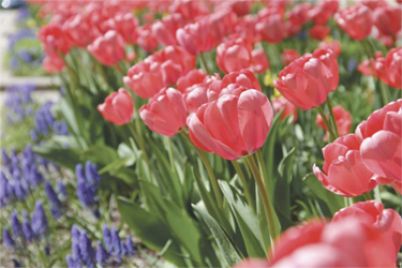By Brittany Dekorte
Editor
A student hustles from their car, running late to class. They move across the parking lot near the OE building, cutting diagonally past the Gateless Gateways statue, curve around the side of the student center, and make their way toward the GM building. Other students cross the path along the way, flowing between buildings like ants.
The students think about their class, their homework, about going home. Rarely do they think about the grass and concrete beneath their feet, or what and who used to stand where they do.
Washtenaw Community College is not very old, especially compared to its neighbors. Eastern Michigan University was founded in 1849, and the University of Michigan celebrated its bicentennial this year. Meanwhile, there are still people alive who remember the space this community college occupied as fruit orchards.
The College’s archives documents the timeline: Back in December of 1965, the newly established board of trustees authorized the purchase of a campus. The new school, having only been authorized the year before, was set to run temporarily out of Willow Run.
Meanwhile, they had reached out to the Franzblau family. Herman and Rose Franzblau were a pair of Jewish immigrants who owned farmland around Michigan, in Manistee, Dexter, and importantly, Huron Farms, located near the Huron River in Ann Arbor.
Huron Farms was the main orchard for the city of Ann Arbor for nearly 30 years. The farm sold produce at the farmers market between the 50s and 70s, supplied for restaurants and groceries, and became one of the first area cider mills, along with Wiard’s Orchard.
“On the farm they grew apples and cherries, and when they bought the farm in 1946 they were lucky enough to have a bumper crop,” said William Birndorf, one of Herman and Rose’s grandsons. He, along with his brothers Howard and Rick, and their cousins David Franzblau and Jo Gilbert, are some of the last people with living memory of the school’s grounds before they were transformed.
According to the grandchildren, their grandfather was considered the “Lettuce King” of Detroit for a long time, as he was the main supplier of it and other produce to restaurants in the city.
When Huron Farms was bought by the family in 1946, it quickly became anchoring point for the whole Franzblau family; a large family home, remembered as “white and mansion-like”, stood on the grounds. Along with the apple and cherry trees, the farm grew peaches; the family had a “victory garden”, left over from WWII, which grew strawberries, raspberries and vegetables. The farm kept animals, too; milk cows, chickens, and horses were grazed in and around the orchards.
Apples were the real heart of the farm, though. “The old adage of the farm was apples for breakfast, apples for lunch, apples for dinner and Herman would come in and say ‘Hey anyone want a snack, how about an apple?” Rick Birndorf said.
The farm housed its own cider press for ciding making. There was a garage with an apple peeler and a cherry pitter, where the fruits were prepared to be sold to pie makers.
None of the buildings still stand on the grounds today; they live on only in the memory of the grandchildren who once knew WCC’s grounds as their summer retreat.
“A wonderful place to grow up,” David Franzblau remembered. “My brothers and sisters and I basically had the run of the place, there were a lot of ways to get in trouble, it’s a wonder we all still have our arms and legs.”
As kids, the cousins had all of their favorite spots: an ice skating pond out in the woods, a tree where they would stash stolen cigarettes, the service roads where they would practice driving for the first time with fork lifts and farm equipment.
One of the said roads the kids nicknamed “Peach Orchard Road”. Where this road once ran, the Student Center building and the Gateless Gateways statue now stand.
The Franzblau family sold the farm to the college a few years after Herman Franzblau died. Even though the land was officially sold in 1968, the farm continued to run through 1972. The animals were sold, but the trees were taken down in phases and still harvested. For a time, some of the farm buildings were re-purposed; the packing house was turned into a facility office, and the barns were used as storage. In time though, these were replaced.
The only remnants left of the Franzblau’s farm is a large stone grill, that lays in the woods between Lot 4F and the school’s service drive.
“It’s sad to drive by and see the college, because in the back of my mind’s eye I can still see the farm,” said William. The cousins agreed though that “if you were going to sell it to anything, the college was the best place to sell it to.”
“It’s better than seeing it decline, than watching it become nothing,” Gilbert said.
Declining farms had also happened to their farms: one of the family farms in Dexter had slipped into disuse and is completely abandoned.
“It was amazing to be a kid and to grow up there,” Gilbert said. “We were all city kids, and all of our friends had to stay in the city, but in the summer and fall we would get to leave and work and play on the farm.”

